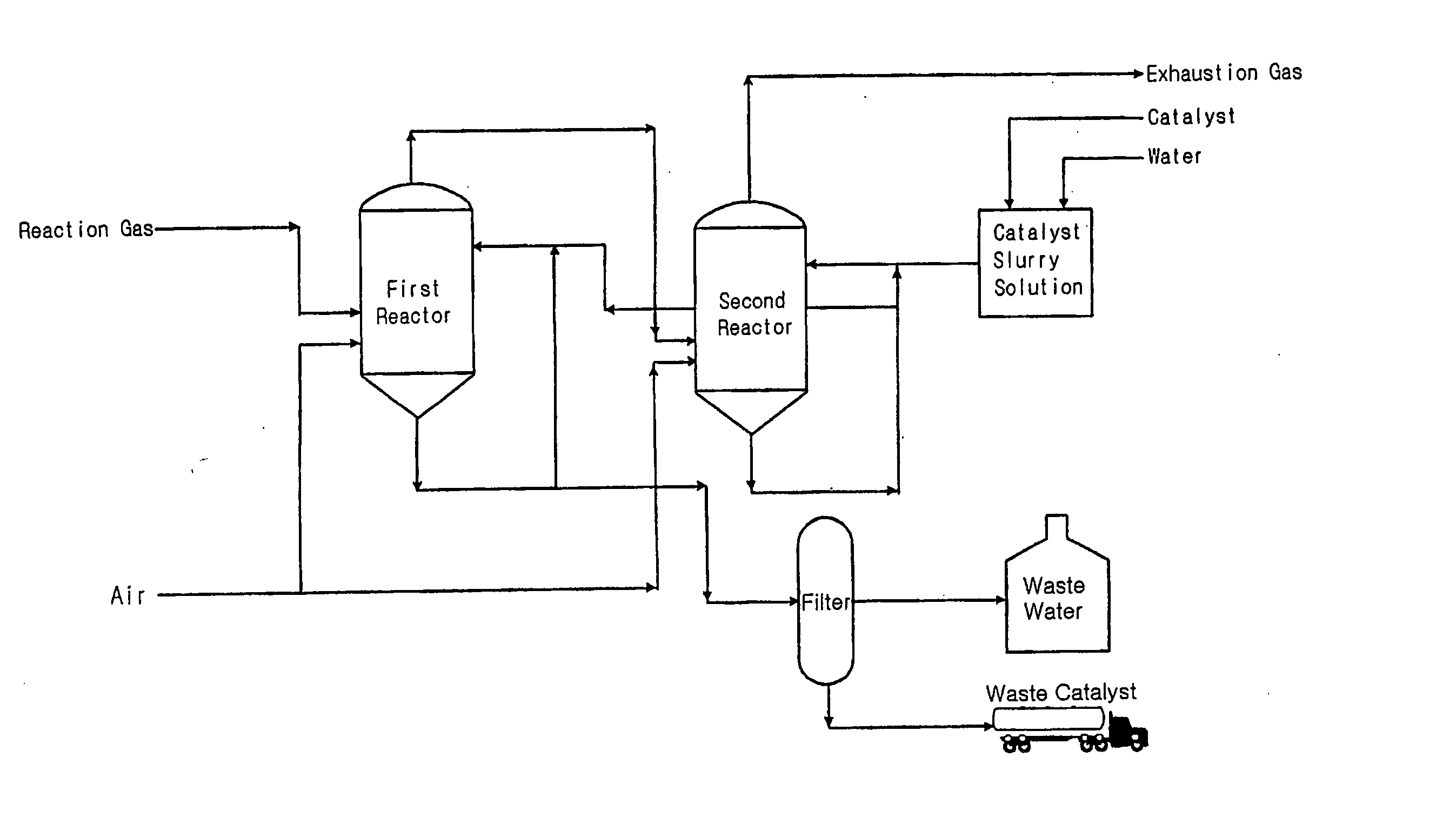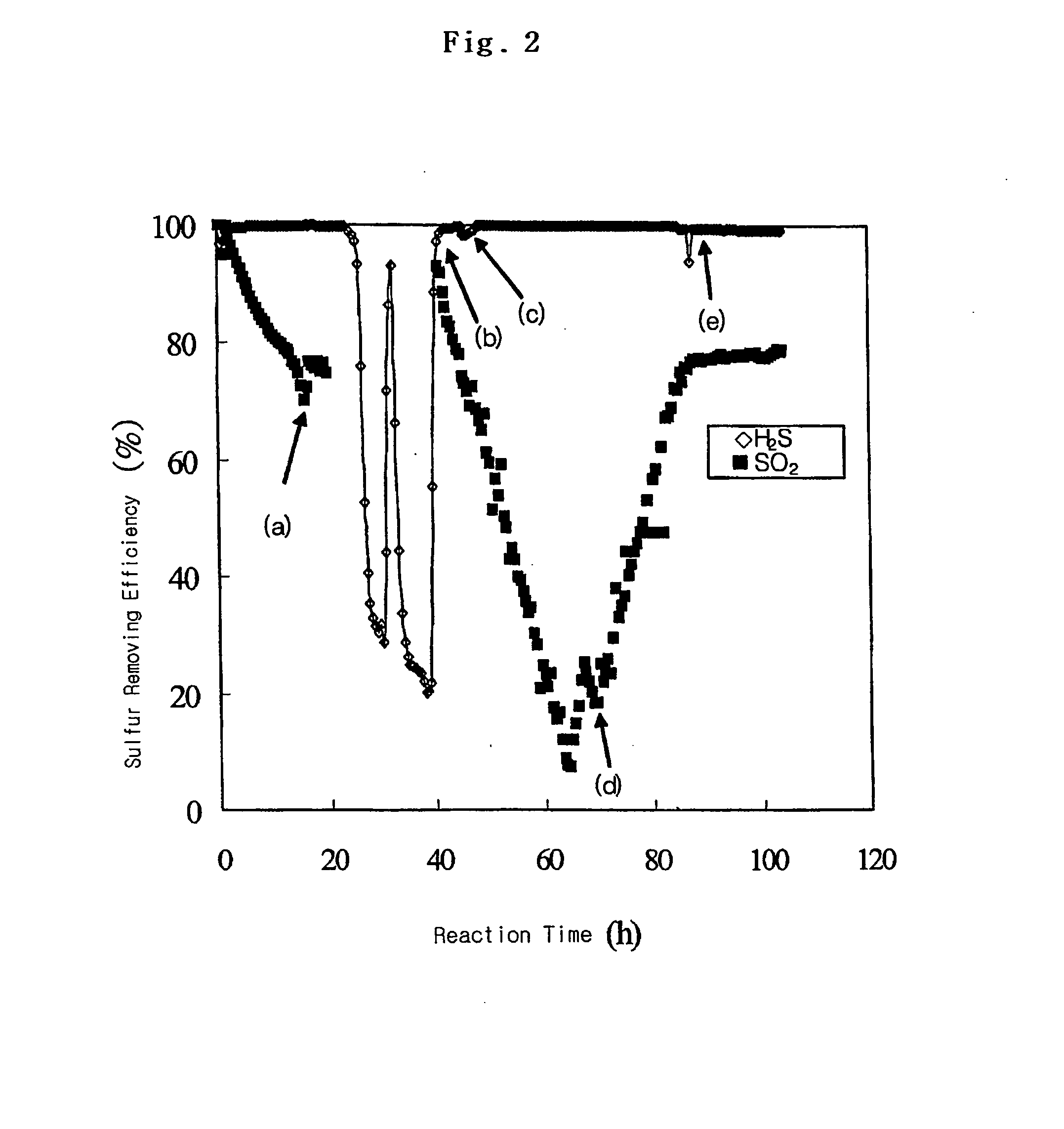Desulfurizartion for Simultaneous Removal of Hydrogen Sulfide and Sulfur Dioxide
a desulfurizing process and hydrogen sulfide technology, applied in the direction of hydrogen sulfides, separation processes, sulfur compounds, etc., can solve the problems of difficult to achieve, environmental problems, and limited application of these processes, and achieve the effect of simple and reliable way and low cos
- Summary
- Abstract
- Description
- Claims
- Application Information
AI Technical Summary
Benefits of technology
Problems solved by technology
Method used
Image
Examples
example 1
[0049] Example 1 shows the effect of simultaneous removal of hydrogen sulfide and sulfur dioxide in batch type wet oxidation reaction without using catalyst.
[0050] 1.5 Liter of water was put into a stirring type reactor, where hydrogen sulfide, sulfur dioxide and air were introduced through a perforated diffuser located at the bottom of the reactor in a way that flow rate of hydrogen sulfide was 10 ml / min, that of sulfur dioxide was 5 ml / min and that of air as an oxidizing agent was 100 ml / min. After the reaction, the product gas was analyzed with gas chromatography and the results were converted into the removing efficiency with the following equation. Removing efficiency(%)=Concentrationin the reaction gas-Concentrationin the product gasConcentrationin the reaction gas⨯100
[0051] The sulfur removing efficiency is shown in FIG. 2 as a function of reaction time. In FIG. 2, (a), (b), (c), (d) and (e) indicate the point when SO2 was off, SO2 was on, H2S was off, ...
example 2
[0053] The procedure of Example 1 was repeated except that 3 g of 6% by weight Fe / MgO catalyst was employed in Example 2. 6% by weight Fe / MgO catalyst was prepared by dispersing 20 g of MgO in 200 ml of water, adding 1 N iron nitrate solution thereto so that Fe becomes 6% by weight in relation to MgO, and then drying and baking the resultant at 450° C.
[0054] The results are shown in FIG. 3. In FIG. 3, (a), (b), (c), (d) and (e) indicate the point when SO2 was off, SO2 was on, H2S was off, H2S was on and when oxidizing agent was changed to nitrogen, respectively.
[0055]FIG. 3 shows that both removing efficiency and simultaneous removing efficiency of hydrogen sulfide and sulfur dioxide are much higher in Example 2 when Fe / MgO catalyst was used than in Example 1 when no catalyst was used. After (e) point when oxidizing agent was changed to nitrogen, removing efficiency of hydrogen sulfide and sulfur dioxide gradually decreased.
example 3
[0056] 3 g of 6% by weight Fe / MgO catalyst was employed and same desulfurization step was repeated as in Example 2 except that reaction gas ratio between hydrogen sulfide and sulfur dioxide was varied at 5:5, 5:15 and 10:5, and that air was used as an oxidizing agent while total gas flow rate being fixed at 110 ml / min.
[0057] As a result, the removing efficiency of hydrogen sulfide was high when the concentration of sulfur dioxide was higher than that of hydrogen sulfide as shown in FIG. 4. This means that sulfur dioxide plays an important role as an oxidizing agent in the inventive desulfurization reaction. Specifically, sudden drop in the removing efficiency was observed at the beginning of the reaction when the ratio between hydrogen sulfide and sulfur dioxide was 5:5 or 10:5, which is indicative of the presence of an induction period in the inventive desulfurization reaction.
PUM
 Login to View More
Login to View More Abstract
Description
Claims
Application Information
 Login to View More
Login to View More - R&D
- Intellectual Property
- Life Sciences
- Materials
- Tech Scout
- Unparalleled Data Quality
- Higher Quality Content
- 60% Fewer Hallucinations
Browse by: Latest US Patents, China's latest patents, Technical Efficacy Thesaurus, Application Domain, Technology Topic, Popular Technical Reports.
© 2025 PatSnap. All rights reserved.Legal|Privacy policy|Modern Slavery Act Transparency Statement|Sitemap|About US| Contact US: help@patsnap.com



